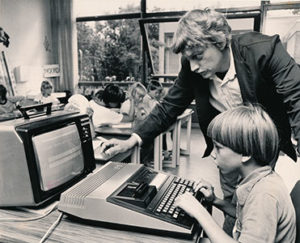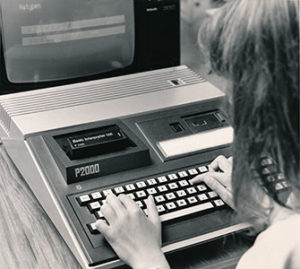The screen emitted a friendly green glow. After entering a CLOAD command followed by a program name, the mini-cassette started whirring. The machine searched eagerly for the program it needed to find. It loaded it into its 16 kilobyte memory, the same amount it takes nowadays to store one single second of music1. The cassette rewound loudly. Just three more letters to start the program: R-U-N. This wasn’t just any computer, it was the Philips P2000T.
A tank
The P2000T was built like a tank. The keyboard and the computer indistinguishably fused into one monolithic device. On the left, above the keyboard area, a cartridge protruded: the BASIC interpreter used for executing programs. Level on the right was the mini-cassette tape drive. Right behind it: a green monitor capable of displaying 24 rows and 40 columns of text. That was it, that was all we had, that was all I needed.
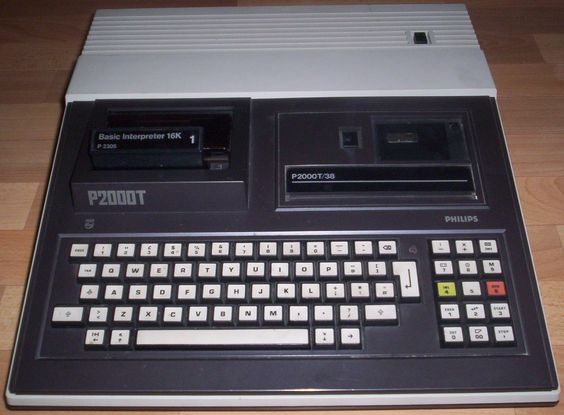
I spent many hours with this computer, more about that later. First: let’s dive into this machine’s story. Why was it created and what powered it? How did it launch into the market? What made it ultimately (un)successful?
Background
The early eighties were marked by a recession. One that also hit Europe. This accelerated the already ongoing shift from a manufacturing-based to services-based society. This was further fueled by the relentless rise of information technology. Hence, western European countries shifted their education programs, aligning their direction with the growing computing industry, in order to remain competitive.
A symbol of this change was the transition from large mainframes to computing devices that could be used in a self-contained way within a home, office or school setting. Being on the technological frontier at the time, Philips was well equipped to jump into this market, and so: they did.
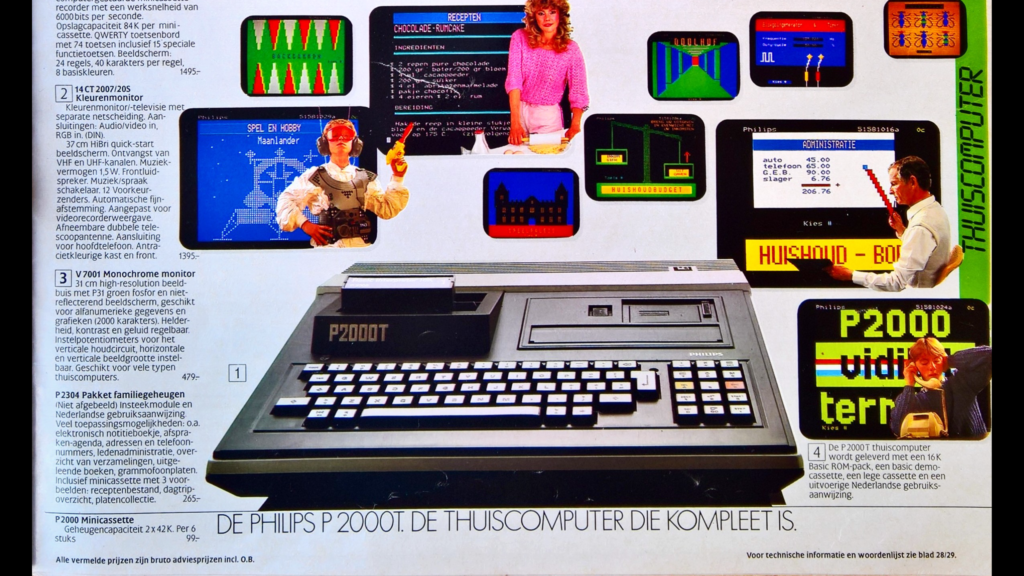
Conceptual Development of the P2000T
In the late seventies Philips developed the Videopac in the United States, better known as the Magnavox Odyssey. This was followed in the early eighties by the P2000 developed in Vienna, Austria. It combined several technologies Philips had either invented or applied previously, namely:
- The mini-cassette system, introduced by Philips in the late sixties, often used for dictation machines.
- The Teletext videochip, created by Philips UK in the early seventies, widely included in televisions.
- The cartridge system (EPROM’s), Philips previously used in the Videopac device, often applied in similar devices at the time.

Mini-cassette 
Teletext character generation chip 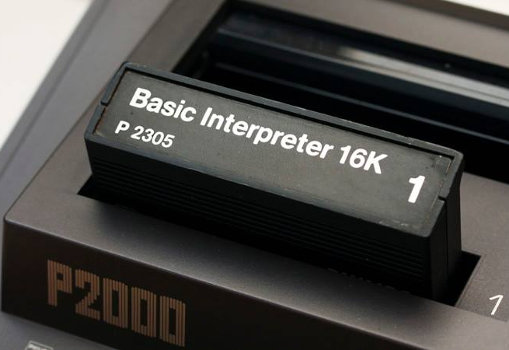
Cartridge
The most common P2000 model was the Tape-only model, P2000T, aimed towards the home computing market. There was also a professional P2000M version with a monitor and two 5,25 inch floppy drives. Even a portable P2000C version existed that housed a higher clocked 4 Megahertz chip. All of these could be extended with peripherals like printers.

“A personal computer to use everywhere”
The Zilog Z80
Two former Intel employees decided to found their own start-up called Zilog. Their first product? The Z80 microprocessor. They had formerly worked on the Intel 4004, 8008 and 8080. Unsurprisingly, the eight bit Z80, running at 2.5 Megahertz, was essentially an iterative improvement of Intel’s 8080 microprocessor. It was much faster and more importantly: much less expensive to produce. These factors contributed to the Z80 finding its way into many contemporary home computing devices. This included the Commodore, the Master System by Sega, the MSX and also the P2000T.
The P2000 line was not restricted to only the Z80 though, or even a specific language or operating system. The P2000C model, which was introduced later, came with an additional built-in Intel 8088 chip for running MS-DOS: Microsoft’s early Disk Operating System. The professional P2000M model came with CP/M, another operating system in vogue at the time.
The Tapes
A unique feature of the P2000 compared to contemporaries was its tape handling. It was able to quickly display the index of a tape, spool the tape automatically and find the next free spot to save a file. All of this without requiring manual user intervention.
This tape magic put the P2000T a cut above the competition, like the MSX and Commodore 64. Add to that the ability to load and save data up to ten times faster than those machines, and the P2000T seemed like a winning proposition at the time. Though, it also had its limitations, particularly on the graphical side: it could only render (tele)text.
Beside the tape, the machine also had a cartridge. This enabled the user to switch between interpreters so that programs could be executed that were written in different languages, such as Fortran, Assembler or Pascal. The most commonly used cartridge was the one containing a BASIC interpreter that allowed the user to type the BASIC language at the command prompt, as well as save programs onto tapes. Officially named Philips Cassette Basic, it was basically (pun intended) Microsoft BASIC.
Launching the P2000
The P2000 was finally launched in 1981 by Philips as their entry in the budding home computing market. Initially it cost 3000 Dutch guilders (2700 EUR today). However, the price quickly dropped to about 1200 guilders (1000 EUR) and within five years had dropped by another fifty percent [18]. The device was received by critics as an ordinary personal computer, not bad, but not really good either. It was praised particularly for Philip’s good service surrounding the device, and the ecosystem for both hardware and software [12].
Employees of Philip’s Physics Lab were a bit taken aback by the P2000’s sudden release. The Vienna department had, more or less, developed the machine in isolation. The people in the Physics Lab were concerned that the commercial part of Philips would mismarket the device solely towards professional users. Hence, they decided to launch their own club around the machine: the Nat. Lab Thuis Computer Club, which later became the P2C2. This helped shift the fate of it the machine in a different direction: that of home and educational usage.
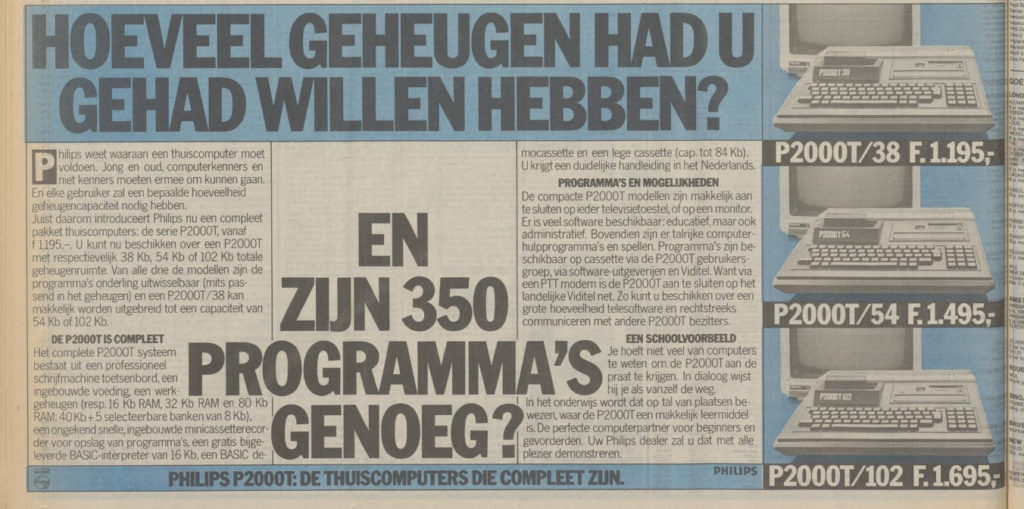
The bold headings are: “How much memory would you like to have?”
and “Are 350 programs enough?”
Thriving Times

Other clubs spawned like the GPC and the P2000gg. The latter under the Hobby Computer Club (HCC) banner. The P2000gg quickly expanded to nearly a thousand members [14, 15]. The enthusiast were more strongly represented in the age ranges ten to thirty and forty to fifty [17]. A small portion of this thriving network of hobbyist developed numerous BASIC programs for the device and further popularized the P2000. Applications developed ranged from games, to educational software, to administrative programs. There were programs for: creating embroidery patterns, book indices, and even faxing.
This was not the result of just mucking around either. The club had set up a system to help improve each other’s work. This included forms to judge each other’s programs leading to iterative improvements, and high quality applications. These were distributed in various ways like copying tapes at gatherings, but also by transmitting programs over the airwaves. For example by the HobbyScoop radio program of the Dutch Broadcast Foundation (NOS) [17].
Though not the only one at its time, this club can be viewed as a precursor to the present-day open source movement. Consider three vital factors. Firstly, the easily copied programs, essentially consisting of open source code. Secondly, the forms-based feedback system being similar to today’s pull requests. Thirdly, the iterative feedback cycle similar to modern SCRUM and Kanban methodology. Though, releasing this way was considered a struggle by some [17].
Role of the P2000T in Education
The P2000T also found its way into Dutch schools. Initially it was used for administrative tasks within schools. However, due to its rugged construction and the availability of educational software, it quickly found its way into the actual classroom. It was in part responsible for the boom between 1981 and 1983 in computers that appeared in the classroom. This rose from 12,5 percent to as much as 40 percent for secondary education.
LEGO Technic Robotica, a precursor to present-day LEGO MindStorms, could also be controlled by the P2000, among other machines. LEGO developed special parts for this including pressure and light sensors [10].
My First Steps with the P2000T
My father being a teacher, we had a P2000T at home, in addition to the ones at school. We mostly used it for playing games. However, one day my brother showed me how to actually change some text in a racing game, by adjusting some lines in the BASIC code of the program. That was the moment I became fascinated with the machine. This also unlocked a broader interest in constructing nice things.
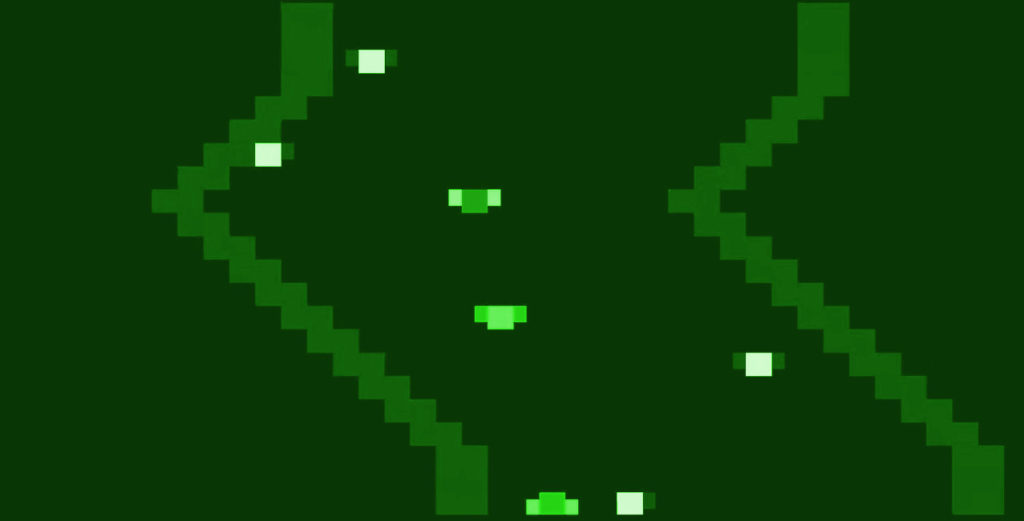
I devoured the 158-page manual, mastering the Philips Cassette BASIC programming language. I spent many hours in its green glow testing the limits of the device (we had a monochrome display, with only shades of green). It was surprisingly versatile, capable of emitting simple sounds, smooth scrolling, and text-based animation. I wrote my first programs, improved existing ones and learned to deal with losing some too in the process of learning. This machine, the P2000T, really was my tricycle into computer science and information technology.
Conclusion
The P2000 was in some ways ahead of its time, existing next to other famous machines of that era, like the various MSX, Commodore, Apple and Atari models. However, like all technology we no longer use today: it was overtaken. In particular by the rise of the IBM-PC clones that took over the market as the eighties came to a close, their prices falling into the range affordable by home users. In that wave, I too, moved on to an PC.
For a deep dive into the nostalgic P2000, there are plenty of resources to explore. Software and documentation can be found on-line [5],an emulator exists [2, 18], as well as various on-line communities [11, 13].
Have you used a P2000T, a different model or another Z80 powered machine? What are your memories of the P2000, or other, home computing machines?
References
- Various. Wikipedia: Philips P2000.
- Kogel, M. (2001) P2000 Architecture.
- Klooster, E. P2000 – A Solid Home Computer.
- Various (2017) Computers in Education.
- Olsthoorn, D. (2019) P2000T Preservation Project.
- Philips (1984). NRC Handelsblad: 16-11-1984.
- Houben, A. (2017) P2000T tested.
- Bram (2019) P2000 documentation.
- Facebook P2000 Community (2013) P2000.
- Miniland (2017) Lego Technic Robotica.
- Retroforum (2020) Philips P2000T Topic.
- Otten, H. J. C. (1982) Radio Bulletin August 1981: P2000 Getest.
- Circuits On-Line (2018) P2000 Topic.
- Various (1985) TRON-01 GPC.
- Various (1984) Radio Bulletin July 1984.
- Various (1985) P2000gg Newsletter Summaries.
- Various (1984) Radio Bulletin September 1984.
- Nico (2019) M2000 Emulator.
Footnotes
- Assuming a 128kbps MP3 file: 128 kilobits / 8 bits-per-byte = 16 Kilobytes


